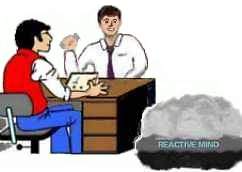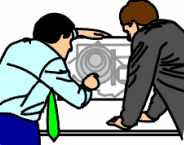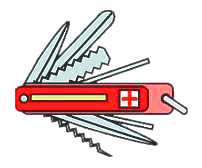Objectives Processes |
||||||||||||||||
|
Objectives Processes Objective processes are physical drills done with observance of the Auditor's Code and other basics of auditing. The objective processes do not depend on verbal commands and they apply ARC on a physical level; they are thus easy to get excellent results with very early on. Objectives can be done as the first audited action on pc's. They are part of the line-up of actions you do to handle the effects of drugs on a case. If not done before, they are done as part of Grade One. If already partly done, any processes omitted earlier are run on Grade One. Even though all the Objective process are not called the CCH's they all build on the same basic principles. CCH stands for Control, Communication, Havingness. The definitions below outline the principles and elements Objectives build on: Objective Processes, 1. Objective Processes deal with body motions and observing and touching objects in the auditing room. 2. They are Look Around or Physical Contact processes and obviously 'objective'. Pc's who have been on drugs obviously have to be run on Objective not subjective processes. Anyone can be brought more into present time with objective processes. CCHs, 1. Are a highly workable set of processes starting with control, going to communication and leading to havingness in that order. 2. several associated processes which bring a person into better control of his body and surroundings, put him into better communication with his surroundings and other people, and increase his ability to have things for himself. They bring him into the present, away from his past problems. 3. You apply control, communication and havingness. When you apply control, you obtain communication which gives the preclear havingness. It is a method of entrance on cases which is very workable. Communication Lag, 1. the length of time it takes between the question to get a logical answer. (In Objectives - the length of time between command and a correct execution). 2. It's a method of telling whether or not a person is sick or well. A person who answers (or executes) quickly and rationally (or executes correctly) is in much better condition than a person who answers after a long consideration. (Abbreviation: Comm Lag). Control, 1. when
we say control, we simply mean willingness to start, stop and
change. 2. you are stating a greater truth when you say that control
is predictable change than if you say control is start, change
and stop because start and stop are, of course, necessary to change. You
might say the thinking or philosophic definition would be predictable
change. 3. positive postulating, which is intention, and the
execution thereof. CCH - ARC on a physical level. On a mest universe level and a body level we have havingness or solid mass in the place of reality; and we have verbalization or physical interchange in place of communication. So understanding takes place in terms of control, mass and communication (interchange). Understanding on a physical level always takes place in the framework of (a) mass and the location of it, (b) verbalization, exchange or interchange, (c) and control for affinity. If one disliked somebody on a mass level one would simply refuse to control him and just walk away. The choice we are talking about is to control or not to control. Don't get this wrong. We are not trying to rephrase or re-do the ARC triangle. We are simply stating the action level of the ARC triangle - how ARC applies to action on a MEST level. Affinity becomes control or lack of it. The R becomes mass and its location or lack of mass and C is some sort of particle interchange, symbols flying back and forth - in solid form.
The general sequence of the Objective Processes go from direct physical control by the auditor of the pc's body and its motions, to introducing distance, and then go on to controlling pc's attention. So if you ever want to err, don't err on the side of being sweet and light. Err on the side of being a heavy-handed parent; a lion tamer or a sports coach. Keep the Auditor's Code, but keep in full control. And if you do that, your pc's can't help recovering, because the hidden factor of Control-Communication -Havingness (CCH) is present in whatever you're running.
Tone 40
Intention is by R. Hubbard defined as 'the
carrier wave, that takes the words along with it.'
As taught on the Upper Indoctrination TR's the auditor has to use intention to go along with the verbal commands. When he gets real good at that he can theoretically state the commands in Chinese, Dutch or any other language the pc doesn't understand and the body will still comply. If the Bank comes in the way and the pc can't comply with a command, the auditor simply reaches in and elegantly physically enforces the compliance. You have to think Control = Affinity when you do that and sort of be like a loving but firm parent teaching a child to walk. The idea, that the pc can't do it does not enter your mind. Here is an actual description of a session running CCH 1-4 done by R. Hubbard. They are run 1,2,3,4,1,2,3,4, etc. "Auditor and pc sat down; auditor chatted a bit about the coming session with the pc. He explained briefly what they were going to do. He started the session. The auditor explained the CCH 1 drill and began on it. The pc had a bit of embarrassment come off. The auditor took the physical reaction as an origination by the pc and asked "What is happening?". The routine CCH 1 drill went on and was shortly proved flat by three equal responses. The auditor went to CCH 2. He explained the drill and they started to do it. This proved to already be flat. The pc did the drill three times without change of Comm lag. The auditor explained and went to CCH 3. This also proved flat and after a three times test, the auditor went on. He explained CCH 4, and they did CCH 4. This was found unflat and was gradually flattened to three equally timed correct responses by the PC on a motion the PC could not at first do. About 50 minutes had elapsed so the auditor gave a ten minute break. After the break the auditor went back to CCH 1, found it flat, went to CCH 2 and found the PC jumping the command and, by putting short waits of different lengths before giving Commands, knocked out the automaticity. The auditor went on to CCH 3, found it flat, and then to CCH 4 which was found unflat and was then flattened." "All commands and actions were Tone 40 (which is not "antagonism" or "challenge"). But the pc was kept in two way comm between full cycles of the drill by the auditor. Taking up each new physical Change manifested as though it were an origin and querying it and getting the pc to give the pc's reaction to it, this two way comm was not Tone 40. Auditor and PC were serious about the drills. There was no relaxation of precision. But both auditor and pc were relaxed and happy about the whole thing. These were the CCH's properly done. With high gain results." "There was no watchdog snarling, no antagonistic suspicion, no pc going out of session, no rough handling, no drill-sergeant screaming or yelling. There was good auditor-pc relationship (better than in formal sessions) and good two way comm throughout."
You don't pay much attention to verbal originations but would of course acknowledge them according to Auditor's Code # 16 (Always maintain good Communication with the preclear and do not cut his communication or let him overrun in session). But you don't go into much more in terms of clarify or understand them because what you are using for communication here are actions and body language. In tone 40 auditing you let nothing come in the way of having your command executed. When that is done you can do a bit of two way comm, not tone 40. A Level One auditor would do the Objectives in Model Session. He would start by flying the rudiments on a Meter to F/N VGI, as an Objective process is a major action (Auditor's Rights). Then they would leave the table and do the objectives away from the Meter set up. So it takes a bigger room with space for a separate set of chairs, moving around, etc. While running the CCH's and other Objective processes the auditor uses the pc's body and physical manifestations as his 'Meter'. He handles any physical manifestation as a 'read' that has to be resolved or flattened. If the pc has a big cognition about the whole thing, the auditor would take the pc over to the Meter set up, write down the pc's statement and note down any F/N VGI's. He will have to complete his report immediately after session as it shouldn't interfere with running the processes.
At one time the following practice was "in style". The auditor ran the pc on a few commands; then took him over to the Meter and had him 'two way communicate' and got an F/N. Auditors would call that for "EP". What actually got the F/N was not the Objective process but the two way communication. This is what we call 'Quickie'. Quickie is bad. It means to do something in a hurry and "doing something less than what could be achieved". Objectives on a new pc takes tens of hours for a full program. Typically 15 - 75 hours. But it takes the time it takes. The full results are achieved by actually doing the processes - not just talking about them. The auditor needs to have enough understanding of the processes to know what he is working towards and what he can expect. He also has to realize that his main focus are on physical manifestations and changes. "The pc's body is the Meter" is the maxim here. What the pc says is less important. It is not uncommon that pc's have
significant gains from these simple processes, including going exterior,
running out incidents with bad control, increased efficiency in getting
things done, etc. Besides "druggie" symptoms they have proven to
be effective to handle lack of concentration, lack of confront and lack of
execution. Phenomena like "Attention deficit disorder", very
nervous and agitated behavior and "Hyper activity" are all
caused by lack of confront and physical ARC with the environment and will
change radically when these processes are run right. The ultimate cure for
Q and A "Man's deadliest disease", is to flatten all the
Objective processes completely. Done as Co Audit
|
||||||||||||||||















